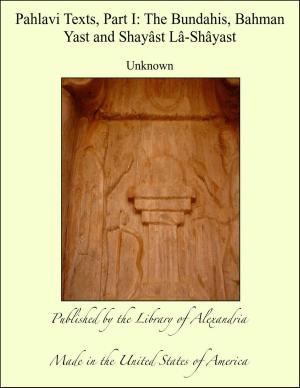| Author: | Lina Eckenstein | ISBN: | 9781465605122 |
| Publisher: | Library of Alexandria | Publication: | March 8, 2015 |
| Imprint: | Language: | English |
| Author: | Lina Eckenstein |
| ISBN: | 9781465605122 |
| Publisher: | Library of Alexandria |
| Publication: | March 8, 2015 |
| Imprint: | |
| Language: | English |
SINAI is the peninsula, triangular in form, which projects into the Red Sea between Egypt and Arabia. The name used to be applied to the mountainous region of the south, now it is made to comprise the land as far north as the Mediterranean. Sinai is famous for the part which it has played in the religious history of mankind. It was at one time a centre of moon-cult, before it became the seat of the promulgation of the Law to the Jews at the time of Moses. In Christian times it was one of the chief homes of the hermits, and the possession of the relics of St. Katherine in the great convent of the south, caused Sinai to be included in the Long Pilgrimage throughout the Middle Ages. A history of Sinai deals with the people who visited the peninsula at different times, rather than with its permanent inhabitants, who, in the course of centuries, seem to have undergone little change. They still live the life of the huntsman and the herdsman as in the days of Ishmael, sleeping in the open, and adding to their meagre resources by carrying dates and charcoal to the nearest centres of intercourse, in return for which they receive corn. The country geographically belongs to Egypt, ethnologically to Arabia. It falls into three regions. In the north, following the coast line of the Mediterranean, lies a zone of drift sand, narrowest near Rafa on the borders of Palestine, widening as it is prolonged in a westerly direction towards Egypt, where it is conterminous with the present Suez Canal. This desert was known in Biblical days as Shur (the wall) of Egypt. “And Saul smote the Amalekites from Havilah (north Arabia), until thou comest to Shur that is over against Egypt” (1 Sam. xv. 7). The military highway from Egypt to Syria from ancient times followed the coast line of the Mediterranean, the settlements along which were modified on one side by the encroachment of the sea, on the other by the invasion of sand. Adjoining this zone of drift sand, the land extends south with increased elevation to the centre of the peninsula, where it reaches a height of about 4000 ft., and abruptly breaks off in a series of lofty and inaccessible cliffs, the upper white limestone of which contrasts brilliantly in some places with the lower red sandstone. This region is, for the most part, waterless and bare. It is known in modern parlance as the Badiet Tîh (the plain of wandering). Its notable heights include the Gebel el Ejneh and the Gebel Emreikah. This plain is drained in the direction of the Mediterranean by the great Wadi el Arish and its numerous feeders, which, like most rivers of Sinai, are mountain torrents, dry during the greater part of the year, and on occasion like the fiumare of Italy, flowing in a spate. The Wadi el Arish is the River of Egypt of the Bible (Gen. xv. 18; Num. xxxiv. 5), the Nahal Muzur of the annals of King Esarhaddon.
SINAI is the peninsula, triangular in form, which projects into the Red Sea between Egypt and Arabia. The name used to be applied to the mountainous region of the south, now it is made to comprise the land as far north as the Mediterranean. Sinai is famous for the part which it has played in the religious history of mankind. It was at one time a centre of moon-cult, before it became the seat of the promulgation of the Law to the Jews at the time of Moses. In Christian times it was one of the chief homes of the hermits, and the possession of the relics of St. Katherine in the great convent of the south, caused Sinai to be included in the Long Pilgrimage throughout the Middle Ages. A history of Sinai deals with the people who visited the peninsula at different times, rather than with its permanent inhabitants, who, in the course of centuries, seem to have undergone little change. They still live the life of the huntsman and the herdsman as in the days of Ishmael, sleeping in the open, and adding to their meagre resources by carrying dates and charcoal to the nearest centres of intercourse, in return for which they receive corn. The country geographically belongs to Egypt, ethnologically to Arabia. It falls into three regions. In the north, following the coast line of the Mediterranean, lies a zone of drift sand, narrowest near Rafa on the borders of Palestine, widening as it is prolonged in a westerly direction towards Egypt, where it is conterminous with the present Suez Canal. This desert was known in Biblical days as Shur (the wall) of Egypt. “And Saul smote the Amalekites from Havilah (north Arabia), until thou comest to Shur that is over against Egypt” (1 Sam. xv. 7). The military highway from Egypt to Syria from ancient times followed the coast line of the Mediterranean, the settlements along which were modified on one side by the encroachment of the sea, on the other by the invasion of sand. Adjoining this zone of drift sand, the land extends south with increased elevation to the centre of the peninsula, where it reaches a height of about 4000 ft., and abruptly breaks off in a series of lofty and inaccessible cliffs, the upper white limestone of which contrasts brilliantly in some places with the lower red sandstone. This region is, for the most part, waterless and bare. It is known in modern parlance as the Badiet Tîh (the plain of wandering). Its notable heights include the Gebel el Ejneh and the Gebel Emreikah. This plain is drained in the direction of the Mediterranean by the great Wadi el Arish and its numerous feeders, which, like most rivers of Sinai, are mountain torrents, dry during the greater part of the year, and on occasion like the fiumare of Italy, flowing in a spate. The Wadi el Arish is the River of Egypt of the Bible (Gen. xv. 18; Num. xxxiv. 5), the Nahal Muzur of the annals of King Esarhaddon.















